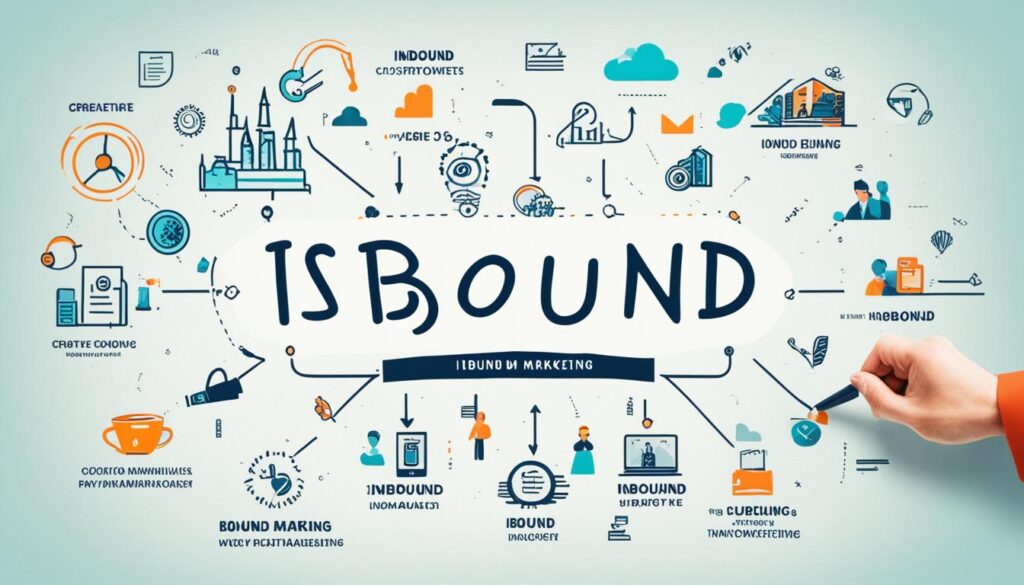Marketing Strategy
Inbound Marketing vs Outbound Marketing: Key Differences

Were you aware that inbound marketing can produce 54% more leads than classic outbound marketing techniques? In the current era of digital advancement, the methodology businesses utilize to attract and engage with customers has dramatically transformed. Both inbound marketing and outbound marketing offer unique strategies and advantages. Recognizing the variances between these methodologies is crucial for devising a marketing strategy that not only reflects your brand’s essence but also connects with your intended market.
Key Takeaways
- Inbound marketing generates more leads compared to outbound marketing.
- Understanding the differences between inbound and outbound marketing is crucial for creating a successful marketing strategy.
- Inbound marketing focuses on attracting customers through valuable content and personalized experiences.
- Outbound marketing relies on interruptive tactics such as cold calling and television ads to reach a wide audience.
- Both inbound and outbound marketing have their advantages and disadvantages, and the right strategy depends on your brand, target audience, and goals.
What is Inbound Marketing?
Inbound marketing is a customer-centric approach to marketing that focuses on attracting potential customers through relevant and valuable content. Unlike traditional outbound marketing methods that interrupt and push messages to a broad audience, inbound marketing aims to pull in prospects naturally by providing helpful information and addressing their specific needs and pain points.
Inbound marketing is all about building trust, establishing credibility, and fostering long-term relationships with customers. By creating engaging content, leveraging various digital channels, and catering to the preferences of your target audience, you can effectively reach and engage potential customers throughout their buyer’s journey.
Definition of Inbound Marketing
Inbound marketing, as defined by HubSpot, is a marketing methodology that focuses on attracting customers through relevant and helpful content and adding value at every stage of their customer journey, resulting in increased brand awareness, engagement, and customer loyalty.
Key Components of Inbound Marketing
- Content Creation: Creating valuable, informative, and engaging content such as blog posts, videos, ebooks, and podcasts that resonate with your target audience.
- Search Engine Optimization (SEO): Optimizing your content and website to rank higher in search engine results, making it easier for potential customers to find you organically.
- Social Media Marketing: Leveraging social media platforms to share your content, interact with your audience, and expand your brand reach.
- Email Marketing: Building a subscriber base and nurturing leads through personalized and targeted email campaigns.
- Lead Generation and Capture: Implementing strategies to attract and capture quality leads through tactics like landing pages, forms, and call-to-action buttons.
- Marketing Automation: Utilizing automation tools to streamline and optimize your marketing efforts, such as lead nurturing, email workflows, and social media scheduling.
- Analytics and Reporting: Monitoring and analyzing data to measure the success of your inbound marketing campaigns and make data-driven decisions.
Benefits of Inbound Marketing
Inbound marketing offers several benefits to businesses:
- Cost-effective: Inbound marketing typically costs less than traditional outbound marketing methods while delivering higher returns on investment (ROI).
- Higher Quality Leads: By attracting prospects who are actively seeking information related to your product or service, inbound marketing generates higher quality leads that are more likely to convert into customers.
- Increased Brand Awareness: Consistently creating valuable content and engaging with your target audience helps to establish your brand as a trusted authority in your industry.
- Long-term Relationships: Inbound marketing focuses on building relationships and nurturing customer loyalty, leading to repeat business and customer advocacy.
- Adaptable and Agile: Inbound marketing allows for flexibility and adaptation as it can be easily adjusted based on real-time data and customer feedback.
How Inbound Marketing Targets Potential Customers
Inbound marketing targets potential customers by aligning your content with their specific needs and pain points. By understanding your target audience’s demographics, interests, and behaviors, you can create content that resonates with them and attracts them to your brand.
Through valuable and relevant content, inbound marketing aims to capture the attention and interest of potential customers, drawing them into your sales funnel. This content may take the form of blog posts, videos, social media updates, podcasts, or downloadable resources. By addressing their concerns and providing solutions, you can establish your brand as a trusted resource and guide potential customers towards making a purchase decision.
Optimizing Inbound Marketing for the Sales Funnel
A crucial aspect of inbound marketing is optimizing your strategies and tactics for each stage of the sales funnel. By creating content that targets customers at different stages of the buyer’s journey, you can guide them through the funnel and nurture them towards conversion.
At the top of the funnel, awareness stage, focus on creating educational and informative content that attracts potential customers to your brand. In the middle of the funnel, consideration stage, provide more in-depth content that addresses specific pain points and positions your brand as a solution. Finally, at the bottom of the funnel, decision stage, offer content that helps potential customers make an informed purchasing decision, such as product demos, case studies, or customer testimonials.
By understanding the unique needs of customers at each stage and aligning your content accordingly, you can optimize your inbound marketing efforts and increase your chances of converting leads into customers.
What is Outbound Marketing?
In this section, we will focus on outbound marketing and its characteristics. Outbound marketing refers to a traditional marketing approach where businesses actively reach out to their target audience through various promotional methods.

Definition of Outbound Marketing
Outbound marketing encompasses all the strategies and tactics used by companies to initiate and direct their marketing messages towards potential customers. This proactive approach involves pushing the brand’s message out to a broader audience in the hope of generating leads and driving sales.
How Outbound Marketing Differs from Inbound Marketing
Outbound marketing differs from inbound marketing in several ways:
- Outbound marketing focuses on interrupting potential customers with promotional content, while inbound marketing aims to attract customers organically through valuable and relevant content.
- Outbound marketing is more traditional and relies on methods such as television and radio ads, cold calling, direct mail, email blasts, and outdoor advertising. In contrast, inbound marketing leverages digital channels like content marketing, search engine optimization (SEO), social media, and email nurturing.
- Outbound marketing casts a wider net, targeting a broad audience to increase brand awareness, while inbound marketing focuses on attracting a specific audience that is more likely to convert into leads or customers.
Understanding the fundamentals of outbound marketing will provide valuable insights into its role and purpose in the marketing landscape. In the next section, we will explore traditional outbound marketing strategies in more detail.
Traditional Outbound Marketing Strategies
In the world of marketing, traditional outbound strategies have long been utilized by brands to reach their target audience. These strategies involve actively reaching out to potential customers through various methods and channels. Let’s explore some traditional outbound marketing tactics and compare them to inbound marketing efforts to uncover their differences and advantages.
Comparing Outbound Marketing Efforts with Inbound
While outbound marketing focuses on a more proactive approach by pushing messages out to a wide audience, inbound marketing takes a more passive approach by attracting potential customers through valuable content and engagement. Outbound marketing efforts rely on interruptive techniques such as cold calling, direct mail, and TV/radio advertisements. In contrast, inbound marketing strategies revolve around content creation, search engine optimization, and social media engagement to draw customers in.
Effectiveness of Outbound Strategies in the Current Market
As the marketing landscape continues to evolve, the effectiveness of outbound strategies has faced challenges. Traditional outbound tactics can often be seen as intrusive or interruptive, leading to decreased engagement and lower response rates.
Consumers are becoming more adept at blocking unwanted marketing messages, whether through ad-blockers, caller ID, or simply tuning out traditional advertising channels.
ROI Comparison between Inbound and Outbound
Return on investment (ROI) is a critical metric for evaluating the success of marketing strategies. Inbound marketing has increasingly gained attention for its ability to generate high-quality leads, nurture relationships, and produce long-term business growth. Its focus on attracting engaged and interested customers provides opportunities for building brand loyalty and increasing conversion rates.
In contrast, outbound marketing may still have its place in certain industries or for specific target audiences, but the ROI can be more challenging to measure, as it relies on reaching a large number of people to find a smaller pool of interested prospects.

| Outbound Marketing | Inbound Marketing | |
|---|---|---|
| Approach | Proactive | Passive |
| Tactics | Cold calling, direct mail, TV/radio ads | Content creation, SEO, social media engagement |
| Effectiveness | Decreased engagement and response rates | Opportunities for building brand loyalty and increasing conversion rates |
| ROI | Challenging to measure, reaching a large number of people to find interested prospects | High-quality leads, nurtured relationships, long-term business growth |
Key Differences Between Inbound and Outbound Marketing
In this section, we will explore the key differences between inbound and outbound marketing in greater detail. We will analyze the approach to target audiences, compare content marketing strategies, discuss marketing software utilization, evaluate conversion rates in both strategies, and consider the role of SEO in inbound and outbound marketing efforts.
Target Audience Approach in Inbound vs Outbound Marketing
One of the key differences between inbound and outbound marketing lies in their target audience approach. Inbound marketing takes a more personalized and customer-centric approach, attracting potential customers through content creation and SEO optimization.
Through tactics such as blogging, social media engagement, and email nurturing, inbound marketing aims to establish trust and build relationships with a targeted audience who have already shown interest in the brand or its products/services. On the other hand, outbound marketing takes a more general and interruption-based approach, where messages are pushed out to a wider audience through channels like TV ads, cold calling, or direct mail.
Outbound marketing aims to reach a large audience in the hopes of capturing the attention of a smaller percentage who may be interested in the offering.
Content Marketing in Inbound vs Outbound
Content marketing plays a crucial role in both inbound and outbound marketing strategies, but the approach and focus differ. Inbound marketing emphasizes creating valuable and relevant content that educates, entertains, or solves problems for the target audience.
The content is optimized for search engines to attract organic traffic and nurture leads. In contrast, outbound marketing uses content to deliver marketing messages. This content is often promotional, such as TV ads, billboards, or radio spots. The content in outbound marketing is designed to capture attention immediately and persuade the audience to take action.
Marketing Software Utilization in Inbound vs Outbound
Another key difference between inbound and outbound marketing lies in the utilization of marketing software. Inbound marketing heavily relies on marketing automation tools, customer relationship management (CRM) systems, and analytics platforms to streamline processes, track leads, and measure performance.
These software solutions enable marketers to automate workflows, personalize communications, and gain insights into customer behavior to improve campaign effectiveness. On the contrary, outbound marketing may not rely as heavily on marketing software, as the focus is more on mass reach and one-way communication rather than individualized interactions.
Conversion Rates in Inbound vs Outbound Marketing Strategies
Conversion rates also differ between inbound and outbound marketing strategies. Inbound marketing tends to have higher conversion rates due to its targeted approach and focus on nurturing leads. By attracting individuals who have already shown interest in the brand or its offerings, inbound marketing can deliver content and experiences that address specific needs and pain points, resulting in higher conversion rates.
On the other hand, outbound marketing typically has lower conversion rates as it casts a wider net and reaches a larger audience, many of whom may not actively seek the promoted product or service.
SEO Utilization in Inbound and Outbound Marketing
Search Engine Optimization (SEO) plays a critical role in both inbound and outbound marketing, but the strategies differ. Inbound marketing relies heavily on SEO to optimize content and web pages for search engines, ensuring that they rank high in organic search results and attract targeted traffic.
The goal is to drive qualified leads to the website by aligning content with user intent and providing value through relevant information. On the other hand, while outbound marketing campaigns may not focus as much on SEO, they can still incorporate SEO elements to improve visibility and discoverability. For example, optimizing landing pages or incorporating relevant keywords in offline advertisements can help increase the effectiveness of outbound marketing efforts.

Advantages and Disadvantages of Inbound Marketing
Inbound marketing offers numerous advantages for businesses looking to attract customers and generate leads. By leveraging inbound marketing strategies, companies can harness the power of content and digital channels to attract and engage their target audience. Here are some of the key advantages of implementing an inbound marketing strategy:
Advantages of Inbound Marketing Strategies
- Improved visibility: Inbound marketing techniques such as search engine optimization (SEO) and content marketing can help businesses rank higher in search engine results, increasing their visibility to potential customers.
- Targeted audience: Inbound marketing allows businesses to focus their efforts on attracting and engaging a specific target audience, resulting in higher-quality leads and conversions.
- Cost-effective: Compared to traditional outbound marketing techniques, inbound marketing can be more cost-effective, as it utilizes digital channels and content creation rather than expensive advertising campaigns.
- Higher customer trust: By providing valuable and relevant content, businesses can establish themselves as thought leaders in their industry, earning the trust and loyalty of their customers.
- Measurable results: Inbound marketing provides businesses with the ability to track and measure the effectiveness of their campaigns, allowing for data-driven decision-making and continuous optimization.
Disadvantages of Inbound Marketing Techniques
While inbound marketing offers many advantages, there are also some potential drawbacks to consider:
- Time-consuming: Building an effective inbound marketing strategy requires time and effort to create high-quality content, optimize websites, and engage with the target audience.
- Longer-term results: Unlike outbound marketing techniques that may yield immediate results, inbound marketing strategies often require patience as they rely on building relationships and trust over time.
- Competitive landscape: Inbound marketing has become increasingly popular, leading to a highly competitive landscape where businesses need to differentiate themselves to stand out.
Comparison to Traditional Outbound Marketing
The differences between inbound marketing and traditional outbound marketing are significant. Inbound marketing focuses on attracting customers through valuable content and engagement, while outbound marketing relies on interruptive tactics such as television ads, direct mail, and cold calling.
Inbound marketing allows for targeted audience reach and personalized messaging, while outbound marketing often has a broader, less targeted approach. Additionally, inbound marketing strategies tend to be more cost-effective and provide measurable results, making them attractive for businesses in the age of digitalization.
Inbound Marketing in the Age of Digitalization

As technology continues to evolve, the importance of inbound marketing in the age of digitalization cannot be overstated. With the rise of social media, search engines, and mobile devices, consumers have more control over the content they consume and how they interact with brands. Inbound marketing allows businesses to adapt to this shift by providing valuable and personalized content that meets the needs of their target audience.
Email Marketing and Inbound Strategy
Email marketing is an integral part of an effective inbound marketing strategy. By leveraging email marketing, businesses can nurture leads, build relationships, and drive conversions. Email campaigns can be personalized based on the recipient’s preferences and behavior, ensuring that the right message reaches the right people at the right time.
However, it is important to strike a balance and avoid overwhelming subscribers with excessive emails, as this can lead to unsubscribes and negative brand perceptions.
In conclusion, inbound marketing offers numerous advantages for businesses looking to attract and engage their target audience. While there are some potential drawbacks to consider, the benefits of inbound marketing strategies, including improved visibility, targeted audience reach, cost-effectiveness, higher customer trust, and measurable results, make it a compelling approach in the age of digitalization. By incorporating email marketing into an inbound strategy, businesses can further enhance their customer relationships and drive conversions.
Advantages and Disadvantages of Outbound Marketing
In this section, we will explore the advantages and disadvantages of using outbound marketing strategies. Understanding the pros and cons of outbound marketing can help you make informed decisions for your marketing efforts.
Advantages of Outbound Marketing Strategies
Outbound marketing strategies offer several advantages that can benefit your brand. Here are some key advantages:
- Wide Reach: Outbound marketing allows you to reach a large audience through various channels such as television, radio, print media, and direct mail.
- Immediate Impact: Outbound marketing techniques like television commercials and billboards can create instant brand awareness and capture the attention of potential customers.
- Tangible and Familiar: Traditional outbound marketing methods, such as print ads and direct mail, provide physical touchpoints that can resonate with consumers and make your brand more memorable.
Disadvantages of Outbound Marketing Techniques
While outbound marketing strategies have their advantages, there are also some potential disadvantages to consider:
- Intrusive: Outbound marketing techniques like telemarketing and cold calling can be seen as intrusive, disrupting consumers’ daily lives and potentially leading to negative brand associations.
- Low Conversion Rates: Outbound marketing methods often have lower conversion rates compared to inbound marketing. The broad reach of outbound strategies may not always target the right audience or generate qualified leads.
- Expensive: Traditional outbound marketing can be costly, especially for startups and smaller businesses with limited marketing budgets. Television ads, billboards, and print media can require significant financial investments.
Traditional Marketing Methods in Outbound Strategies
Outbound marketing strategies heavily rely on traditional marketing methods. These methods include:
- Television and radio advertisements
- Print media – newspapers, magazines, and brochures
- Direct mail campaigns
- Outdoor advertising – billboards, banners, and signage

Effect of Telemarketing and Cold Calling on Outbound Marketing
Telemarketing and cold calling are popular outbound marketing techniques that involve direct communication with potential customers over the phone. The effect of these techniques on outbound marketing can vary:
- Immediate Engagement: Telemarketing and cold calling allow for immediate interaction with potential customers, enabling businesses to answer questions, address concerns, and provide personalized information.
- Possible Rejection: These techniques can be met with resistance and rejection from consumers who may see them as intrusive and disruptive to their privacy.
- Regulatory Compliance: Telemarketing and cold calling are subject to legal regulations, such as Do Not Call lists, which can impact the effectiveness and reach of these strategies.
Comparison to Modern Inbound Strategies
When comparing outbound marketing strategies to modern inbound strategies, several key differences emerge:
- Targeted Approach: While outbound marketing targets a wide audience, inbound marketing focuses on attracting and engaging a specific target audience through personalized and relevant content.
- Permission-Based: Inbound marketing relies on permission-based marketing, where customers willingly engage with your brand by providing contact information or opting in to receive communication.
- Relationship Building: Inbound marketing focuses on building long-term relationships with customers through content, social media engagement, and personalized experiences.
- Higher Conversion Rates: Inbound marketing generally yields higher conversion rates compared to outbound strategies due to its personalized targeting and emphasis on building trust and credibility.
Conclusion
After thoroughly exploring the key differences between inbound marketing and outbound marketing, it is clear that both strategies have their own strengths and weaknesses.
Inbound marketing focuses on attracting potential customers by creating valuable content, optimizing search engine visibility, and nurturing leads. This approach allows businesses to establish meaningful connections with their target audience, build trust, and ultimately drive organic growth. However, it requires a long-term commitment, as generating results may take time.
Outbound marketing, on the other hand, relies on more traditional tactics such as cold calling, telemarketing, and advertising to reach and engage a broader audience. Although outbound marketing strategies can generate immediate results, they may also be seen as intrusive or disruptive by the target audience. This approach often requires a larger budget and may not provide the same level of personalization as inbound marketing.
When choosing the right marketing approach for your brand, it is crucial to consider your specific goals, target audience, and available resources. Inbound marketing is ideal for businesses looking to establish long-term relationships, establish thought leadership, and create brand advocates.
On the other hand, outbound marketing can effectively generate quick leads, increase brand awareness, and reach a wider audience. Ultimately, a combination of both strategies may provide the best results, allowing you to leverage the strengths of each approach.
FAQ
What are the key differences between inbound marketing and outbound marketing?
Inbound marketing focuses on attracting potential customers through relevant content and experiences, while outbound marketing involves reaching out to potential customers via traditional marketing methods.
What is inbound marketing?
Inbound marketing is a strategy that is designed to attract and engage potential customers by providing valuable, informative, and relevant content.
What are the key components of inbound marketing?
The key components of inbound marketing include content creation, SEO optimization, social media marketing, lead generation, and nurturing potential customers through the sales funnel.
What are the benefits of implementing an inbound marketing strategy?
Implementing an inbound marketing strategy can help increase brand awareness, generate leads, build customer trust and loyalty, and ultimately, drive higher conversion rates.
How does inbound marketing target potential customers?
Inbound marketing focuses on creating valuable content that aligns with the interests and needs of the target audience. By providing answers to their questions and resolving their pain points, inbound marketing attracts potential customers who are already interested in the products or services being offered.
How can inbound marketing be optimized to maximize its effectiveness throughout the sales funnel?
Inbound marketing can be optimized by strategically creating and distributing content that matches the different stages of the sales funnel. This involves capturing leads through targeted content, nurturing leads with personalized communications, and converting leads into customers through persuasive content and experiences.
What is outbound marketing?
Outbound marketing is a traditional marketing approach that involves pushing messages and promotions to a wide audience in the hopes of generating leads and sales.
What are the traditional outbound marketing strategies?
Traditional outbound marketing strategies include methods such as cold calling, direct mail, trade shows, radio ads, television ads, and billboard advertisements.
How do outbound marketing efforts compare to inbound marketing tactics?
Outbound marketing strategies like cold calling and direct mail are less targeted and personalized compared to inbound marketing tactics. Inbound marketing focuses on drawing potential customers through valuable content and engaging experiences, while outbound marketing pushes messages out to a broader, less targeted audience.
What are the advantages and disadvantages of implementing an inbound marketing strategy?
The advantages of implementing an inbound marketing strategy include higher conversion rates, increased brand visibility, improved customer trust and loyalty, and a more cost-effective approach. However, the potential drawbacks include the need for lots of time and effort to create and distribute valuable content consistently.
What are the advantages and disadvantages of using outbound marketing strategies?
The advantages of using outbound marketing strategies include reaching a wider audience, generating immediate leads, and leveraging traditional marketing platforms like television and radio. However, the potential drawbacks include higher costs, lower conversion rates, and the possibility of reaching an uninterested or unengaged audience.
What are the key differences between inbound and outbound marketing?
The key differences between inbound and outbound marketing lie in their approach to target audiences, content marketing strategies, utilization of marketing software, conversion rates, and the role of SEO in their marketing efforts.
Bryn – AI Expert Writer Bryn is the wizard of words and AI at Influenctor. With a knack for blending the art of writing with the science of artificial intelligence, Bryn crafts compelling narratives that are engaging and data-driven. Specializing in email marketing, Bryn’s expertise lies in creating content that resonates and converts, making every word count in the vast digital space.
Marketing Strategy
Right Brain Marketing vs. Left Brain Marketing

Have you ever pondered why certain ads immediately strike a chord with you, while others don’t leave any impression? Why do some marketing campaigns pull on your emotions, while others target your rational thought?
Well, the answer may lie in the concepts of right brain marketing and left brain marketing. These two approaches to marketing tap into different aspects of human cognition, each with its own set of unique strategies and characteristics.
To explain this further, let me share a little story with you. Imagine walking into a shoe store, seeking the perfect pair for an upcoming event. As you browse through the shelves, a sleek, stylish shoe catches your eye. It’s beautifully designed, with intricate details and vibrant colors. Instantly, you’re drawn to it, picturing yourself walking confidently in those shoes, making a fashion statement. This scenario perfectly embodies the essence of right brain marketing – captivating you through creativity, aesthetics, and emotional appeal.
Right Brain Marketing vs. Left Brain Marketing:
| Aspect | Right Brain Marketing | Left Brain Marketing |
|---|---|---|
| Focus | Creativity, storytelling, imagination, intuition | Logical, analytical thinking |
| Audience | Wider audience due to emotional appeals | Niche audience, effective for specific scenarios |
| Effectiveness | Helpful in creating a memorable brand image | Effective for data-driven and analytical tasks |
| Typical Scenarios | B2C marketing, brand building | B2B marketing, data analysis |
| Approach | Storytelling, visuals, metaphors | Facts, statistics, clear messaging |
| Engagement Style | Building relationships, inspiring | Convincing, educating |
| Content Type | Videos, images, infographics | Charts, graphs, lists |
| Communication Style | Persuasive, empathetic, holistic | Direct, structured, sequential |
| Decision Making | Based on feelings, personal experiences | Based on evidence, logical reasoning |
| Key Strengths | Brand loyalty, emotional connection | Clear information, efficient problem-solving |
| Marketing Tools | Social media, influencer marketing, branding | SEO, email marketing, data analysis |
| Target Audience | Consumers driven by experiences, values | Consumers driven by efficiency, effectiveness |
Now, as you continue your search, you come across another shoe that piques your interest. It’s displayed with a detailed description highlighting the shoe’s comfort, durability, and advanced technology. You carefully consider its features, contemplating how it will support your feet and ensure a comfortable experience. This particular shoe represents the principles of left brain marketing – relying on logical reasoning, factual information, and analytical thinking to make a persuasive case.
This simple shoe store experience demonstrates the power of both right brain and left brain marketing strategies. By combining the emotional impact of creative storytelling with the rationality of data-driven insights, businesses can develop well-rounded marketing campaigns that effectively engage and persuade their target audience.
So, whether you’re a marketer looking to fine-tune your approach or a business owner seeking to enhance your marketing efforts, understanding the differences between right brain and left brain marketing is crucial. In the following sections, we will delve deeper into these concepts, exploring their characteristics, impact on marketing strategies, practical implementation, and the challenges and solutions associated with leveraging both approaches in unison.
Key Takeaways:
- Right brain marketing and left brain marketing tap into different aspects of human cognition, utilizing unique strategies.
- Right brain marketing focuses on creativity, aesthetics, and emotional appeal.
- Left brain marketing relies on logical reasoning, factual information, and analytical thinking.
- The combination of both approaches enables businesses to develop well-rounded marketing campaigns.
- Understanding the differences between right brain and left brain marketing is crucial for effective marketing strategies.
Understanding the Concepts of Right Brain and Left Brain
In this section, we will explore the fascinating concepts of right brain and left brain and gain a deeper understanding of their functions and characteristics. These two hemispheres of the brain play crucial roles in shaping our thoughts, behaviors, and decision-making processes.
Exploring the Functions of the Right Brain
The right brain is associated with creativity, intuition, and holistic thinking. It is responsible for processing emotions, recognizing patterns, and visualizing possibilities. This hemisphere allows us to think outside the box, explore imaginative ideas, and engage in artistic endeavors. It brings a unique perspective to the table and helps us tap into our creative potential.
Understanding the Characteristics of the Left Brain
On the other hand, the left brain is known for its analytical and logical thinking. It excels in tasks that require reasoning, language processing, and mathematical calculations. The left hemisphere focuses on details, follows sequential patterns, and relies heavily on facts and figures. It is essential for problem-solving and critical thinking in various domains.
The Impact of Right Brain Thinking on Marketing Strategies
Right brain thinking can have a profound impact on marketing strategies. By tapping into the creative abilities of the right brain, marketers can develop innovative and captivating campaigns that resonate with their target audience. The right brain enables the use of storytelling, aesthetics, and emotional connections to make marketing messages more memorable and engaging.
How Left Brain Dominance Influences Marketing Decisions
Left brain dominance influences marketing decisions by bringing a data-driven approach to the table. Marketers with a dominant left brain tend to rely on analytical insights, market research, and statistical data to make informed decisions. They strive for accuracy, measurable outcomes, and ROI-driven strategies. Left brain thinking ensures that marketing efforts are grounded in evidence and effectiveness.
Utilizing Both Sides of the Brain in Marketing Campaigns
While right brain thinking and left brain dominance have their unique strengths, the most effective marketing campaigns often utilize both sides of the brain. By blending creativity with analytical thinking, marketers can create well-rounded strategies that appeal to emotions while also delivering measurable results. Finding the right balance between the two hemispheres can unlock the full potential of marketing campaigns.
| Hemisphere | Functions | Characteristics |
|---|---|---|
| Right Brain | Creativity, Intuition, Holistic thinking | Emotional processing, Pattern recognition, Visualization |
| Left Brain | Analytical thinking, Logical reasoning | Language processing, Mathematical calculations, Detail-oriented |
Implementing Right Brain and Left Brain Strategies in Marketing
In this section, we will discuss the practical application of both right brain and left brain strategies in marketing. By harnessing the power of creative marketing and analytical marketing, businesses can create compelling and data-driven marketing campaigns that resonate with their target audience.
Utilizing creative and imaginative elements in marketing campaigns
One of the key aspects of right brain marketing is the use of creative and imaginative elements in marketing campaigns. By tapping into emotions and capturing attention through visually appealing content, businesses can establish a strong brand identity and engage with their audience on a deeper level. Creative marketing techniques such as storytelling, unique visuals, and memorable experiences can leave a lasting impression on consumers and differentiate a brand from its competitors.
To illustrate the impact of creative marketing, consider the following example:
A well-known clothing brand successfully implemented a creative marketing campaign by featuring captivating and artistic visuals in their advertisements. By leveraging the power of imagination, they were able to evoke emotions and resonate with their target audience, resulting in increased brand awareness and customer loyalty.
Applying analytical and logical approaches to marketing tactics
While right brain marketing focuses on creativity, left brain marketing emphasizes analytical and logical approaches. It involves leveraging data-driven insights to make informed decisions and optimize marketing tactics. By utilizing analytical tools and techniques, businesses can identify trends, measure campaign performance, and tailor their marketing strategies accordingly. Analytical marketing enables businesses to optimize their return on investment and optimize their marketing efforts.
Take a look at the following example to understand the impact of analytical marketing:
A software company employed analytical marketing techniques to track user behavior and measure the effectiveness of their digital advertising. By analyzing customer data and conversion rates, they were able to identify areas for improvement and optimize their marketing tactics, leading to increased engagement and higher conversion rates.
Integrating emotional storytelling in right-brained marketing efforts
Emotional storytelling is an effective technique often used in right-brained marketing efforts. By crafting narratives that evoke emotions, businesses can connect with their audience on a deeper level and establish a sense of trust and authenticity. Emotional storytelling allows brands to create a personal connection with consumers, leading to long-term brand loyalty and customer advocacy.
Consider the example below to understand the impact of emotional storytelling:
A non-profit organization used emotional storytelling to raise awareness and funds for a social cause. Through powerful narratives and real-life stories, they were able to evoke empathy and inspire action among their target audience. Their right-brained marketing approach resulted in increased support and engagement from individuals and organizations.
Utilizing data-driven insights in left-brained marketing solutions
Data-driven insights play a crucial role in left-brained marketing solutions. By analyzing data and using quantitative measures, businesses can make informed decisions and optimize their marketing strategies. Data-driven marketing allows for targeted messaging and precise audience segmentation, ensuring that the right message reaches the right people at the right time.
Consider the example below to understand the impact of data-driven insights:
An e-commerce company used data-driven insights to personalize their marketing messages based on customer preferences and past purchases. By analyzing customer data and segmenting their audience, they were able to deliver targeted marketing campaigns, resulting in higher conversion rates and increased customer satisfaction.
The role of right-brained marketing in B2B marketing strategies
In addition to its application in B2C marketing, right-brained marketing techniques can also play a crucial role in B2B marketing strategies. Building strong relationships and trust with business clients is essential for long-term success in the B2B sector. By utilizing creative marketing and emotional storytelling, businesses can differentiate themselves from competitors and establish a deeper connection with their B2B audience. Right-brained marketing techniques can help businesses showcase their unique value proposition, build credibility, and foster meaningful partnerships.
Now let’s take a look at how B2B companies can benefit from right-brained marketing strategies:
A technology solutions provider implemented a right-brained marketing approach by using creative visuals and emotional storytelling in their B2B marketing efforts. By appealing to the human aspect of decision-making, they were able to resonate with their B2B audience, build trust, and establish themselves as a reliable and innovative partner. This, in turn, led to increased collaboration and long-term business relationships.
Implementing Right Brain and Left Brain Strategies in Marketing
| Right Brain Strategies | Left Brain Strategies |
|---|---|
| Utilizing creative marketing techniques | Applying analytical tools and techniques |
| Emphasizing emotional storytelling | Utilizing data-driven insights |
| Aiming for personal connection and brand loyalty | Targeting specific audience segments |
| Building trust and credibility | Optimizing marketing tactics |

By combining creative marketing and analytical marketing, businesses can create well-rounded and effective marketing strategies. Incorporating both right brain and left brain strategies allows for a holistic approach that connects with consumers on an emotional level while also leveraging data-driven insights for optimal results.
Challenges and Solutions in Right Brain vs. Left Brain Marketing
In the realm of marketing, striking a balance between creativity and data-driven approaches is essential for success. Navigating this delicate equilibrium can present challenges, but with the right strategies, marketers can overcome them and harness the power of both right brain and left brain thinking.
Navigating the balance between creativity and data-driven marketing
One of the main challenges marketers face is finding the optimal blend of creativity and data-driven decision-making. While creativity fuels innovation and resonates with audiences, data provides valuable insights and ensures targeted strategies. The key lies in leveraging creativity to capture attention and evoke emotions, while using data to guide decision-making and optimization.
Addressing the common misconceptions about left-brained and right-brained marketers
There are common misconceptions about left-brained and right-brained marketers. Left-brained marketers are often seen as analytical and logical, while right-brained marketers are viewed as creative and intuitive. However, this oversimplification fails to acknowledge that effective marketers can tap into both approaches. Overcoming these misconceptions is crucial in embracing the power of integrated thinking.
Overcoming the challenges in integrating left and right brain approaches in marketing roles
Integrating left and right brain approaches within marketing roles requires a deliberate effort to bridge the gap between analytical thinking and creative ideation. The challenges lie in fostering collaboration, ensuring open communication, and valuing diverse perspectives. By creating an environment that embraces both approaches, marketers can unlock the full potential of their teams.
Optimizing marketing and sales alignment through a combination of left and right brain strategies
Marketing and sales alignment is vital for optimal business performance. By integrating both left and right brain strategies, marketers can effectively communicate the value proposition to potential customers and align their messaging with sales efforts. The analytical approach allows for rigorous measurement and optimization, while the creative approach ensures compelling storytelling that resonates with the target audience.
Utilizing marketing automation to leverage both left and right-brained tactics
Marketing automation is a powerful tool that can assist in leveraging both left and right-brain tactics. Automation streamlines repetitive tasks, allowing marketers to focus on higher-level strategy and creativity. With the right automation tools and processes in place, marketers can effectively combine data-driven insights with creative execution.
| Challenges | Solutions |
|---|---|
| Finding the right balance between creativity and data-driven marketing | Embrace a mixed-method approach, using data to inform creative decisions and vice versa |
| Addressing common misconceptions about left-brained and right-brained marketers | Educate stakeholders about the importance of integrated thinking and the value it brings to marketing efforts |
| Integrating left and right brain approaches | Create a collaborative environment, foster open communication, and value diverse perspectives |
| Optimizing marketing and sales alignment | Align messaging, collaborate closely with sales teams, and measure the impact of marketing efforts |
| Utilizing marketing automation | Implement automation tools and processes to streamline tasks and free up time for creative ideation |
Leadership and Expert Insights in Right Brain Marketing and Left Brain Marketing
In this section, we will provide insights from industry leaders and experts on the topic of right brain marketing and left brain marketing. Effective leadership plays a crucial role in managing teams composed of left-brained and right-brained marketers. By understanding the unique strengths and perspectives of each team member, leaders can foster collaboration and ensure optimal performance.
We will also delve into the insights shared by Chief Marketing Officers (CMOs) on the role of left and right brain thinking in marketing efforts. CMOs bring extensive experience and expertise to the table, sharing valuable insights on how to leverage the best of both approaches to drive impactful marketing campaigns.
Expert perspectives on the future of right-brained and left-brained marketing in the digital age will be explored. As technology continues to advance, it is important to understand how these marketing strategies may evolve and adapt to meet the changing needs of consumers.

We will also examine the influence of Jon Evans in the evolution of brain-oriented marketing. Jon Evans, a prominent figure in the industry, has contributed significantly to the understanding and application of right brain marketing techniques. By exploring his contributions, we gain valuable insights into the potential impact of these strategies.
Lastly, we will discuss the potential impact of right brain marketing on marketing roles and responsibilities. As the marketing landscape continues to shift, it is crucial to consider how these strategies may shape the future of the industry and the skills required for success.
Strategies for Effective Leadership in a Team Composed of Left-Brained and Right-Brained Marketers
Insights from Chief Marketing Officers on the Role of Left and Right Brain Thinking in Marketing Efforts
Expert Perspectives on the Future of Right-Brained and Left-Brained Marketing in the Digital Age
The Influence of Jon Evans and His Contributions to the Evolution of Brain-Oriented Marketing
Exploring the Potential Impact of Right Brain Marketing on Marketing Roles and Responsibilities
| Leadership Strategies | CMO Insights | Expert Perspectives |
|---|---|---|
| Emphasize collaboration and leveraging diverse perspectives | Utilize the strengths of both approaches for impactful campaigns | Explore emerging trends and technologies in marketing |
| Encourage open communication and foster a culture of creativity | Balance creativity with data-driven decision-making | Evaluate the future of marketing in the digital age |
| Set clear goals and provide guidance for the team | Adapt strategies to meet the evolving needs of consumers | Consider the influence of Jon Evans in shaping marketing strategies |
Conclusion
In conclusion, understanding the concepts of right brain and left brain is crucial in developing effective marketing strategies. By incorporating both approaches, businesses can harness the power of creativity and data-driven decision-making to achieve optimal results.
Throughout this article, we explored the unique characteristics of each hemisphere and their impact on marketing. We discussed how right brain marketing leverages creative and imaginative elements, such as emotional storytelling, to capture consumers’ attention and evoke emotions. On the other hand, left brain marketing emphasizes analytical and logical approaches, utilizing data-driven insights to inform decision-making.
However, it is important to find a balance between these two approaches. Marketing strategies that combine the strengths of both right brain and left brain thinking are more likely to resonate with consumers and drive success. By integrating creativity with data-driven insights, businesses can create compelling campaigns that are both engaging and effective.
As the marketing landscape continues to evolve, it is essential for marketers to embrace both right brain and left brain marketing. By understanding the potential impact of each approach, marketers can adapt to changing consumer preferences and stay ahead of the competition. By leveraging the strengths of both sides of the brain, businesses can develop unique and impactful marketing strategies that drive growth and achieve their goals.
FAQ
What is right brain marketing and left brain marketing?
Right brain marketing focuses on creative and emotional elements, while left brain marketing relies on logic and analytics.
How do right brain and left brain approaches differ in marketing strategies?
Right brain marketing emphasizes creativity, storytelling, and emotional connections, while left brain marketing prioritizes analytical thinking, data-driven decisions, and logical approaches.
What are some key characteristics of right brain and left brain thinking?
Right brain thinking is associated with creativity, intuition, and holistic understanding, while left brain thinking is linked to analysis, organization, and logical reasoning.
How can businesses utilize both sides of the brain in their marketing campaigns?
Businesses can leverage both right brain and left brain strategies by combining creative elements and emotional storytelling with data-driven insights and analytical approaches.
What is the role of right-brained marketing in B2B strategies?
Right-brained marketing plays a crucial role in building strong relationships, trust, and emotional connections with business clients in B2B marketing strategies.
What challenges are faced when integrating right brain and left brain approaches in marketing?
The main challenge is finding the right balance between creativity and data-driven decision-making. It requires aligning both approaches to optimize marketing efforts effectively.
How can businesses overcome common misconceptions about left-brained and right-brained marketers?
By promoting open communication, collaboration, and leveraging diverse perspectives within marketing teams, businesses can overcome these misconceptions and benefit from a well-rounded approach.
How can marketing automation help leverage left and right-brained tactics?
Marketing automation tools can assist in efficiently implementing both creative and analytical strategies, allowing businesses to harness the power of left and right brain thinking in their automated marketing campaigns.
What is the significance of effective leadership in teams composed of left-brained and right-brained marketers?
Effective leadership plays a critical role in fostering collaboration and maximizing the strengths of both left-brained and right-brained marketers, resulting in innovative marketing strategies and successful outcomes.
What is the influence of Jon Evans in the field of brain-oriented marketing?
Jon Evans is a notable figure in the field of brain-oriented marketing, contributing to the understanding of how right brain and left brain thinking can be leveraged in marketing to achieve optimal results.
Bryn – AI Expert Writer Bryn is the wizard of words and AI at Influenctor. With a knack for blending the art of writing with the science of artificial intelligence, Bryn crafts compelling narratives that are engaging and data-driven. Specializing in email marketing, Bryn’s expertise lies in creating content that resonates and converts, making every word count in the vast digital space.
Marketing Strategy
How to Create a Successful Marketing Plan: Tips and Templates

Were you aware that companies possessing a clearly written marketing plan stand a 313% greater chance of attaining their objectives compared to those that do not have one? Establishing a solid marketing strategy is crucial for stimulating growth and efficiently connecting with your intended market. This piece will navigate you through the marketing planning process, offering insightful advice and templates designed to assist you in developing an effective marketing plan for your enterprise.
Key Takeaways:
- A documented marketing plan increases your chances of success by 313%.
- A well-defined marketing strategy is essential for driving growth and reaching your target audience effectively.
- In this article, we will guide you through the marketing planning process and provide valuable tips and templates to help you create a successful marketing plan for your business.
What is a Marketing Plan and Why Do You Need One?
In the world of business, a well-crafted marketing plan is essential for success. A marketing plan serves as a comprehensive roadmap that outlines your marketing strategy, objectives, and tactics. It helps you effectively allocate resources, identify target audiences, and implement marketing initiatives that drive business growth.
But why exactly do you need a marketing plan? The answer lies in its ability to provide clarity, focus, and direction. A marketing plan ensures that you have a clear understanding of your goals and how to achieve them. It helps you stay on track, make informed decisions, and measure your progress along the way.
Understanding the Purpose of a Marketing Plan
The purpose of a marketing plan is to provide a structured framework for your marketing activities. It helps you define your target market, analyze competitors, and establish a unique value proposition. By understanding your target audience and their needs, you can tailor your marketing messages and tactics to effectively reach and engage them.
Benefits of Implementing a Marketing Plan
Implementing a marketing plan offers a range of benefits for your business. Firstly, it enables you to align your marketing activities with your overall business objectives, ensuring that every effort contributes to the growth and success of your company. Secondly, a marketing plan helps you allocate resources wisely, maximizing your return on investment. Finally, a well-executed marketing plan enhances brand awareness, builds customer loyalty, and drives revenue.
Key Components of an Effective Marketing Plan
An effective marketing plan consists of several key components:
- Market research: Understand your target audience, their preferences, and behaviors.
- Marketing objectives: Set clear and measurable goals for your marketing efforts.
- Target market analysis: Identify your ideal customers and develop customer profiles.
- Competitor analysis: Evaluate your competitors’ strengths, weaknesses, and strategies.
- Marketing strategies: Choose the most effective tactics to reach your target audience.
- Budget and timeline: Allocate resources and establish a realistic timeline for implementation.
- Measurement and evaluation: Define metrics to track and evaluate the success of your marketing initiatives.
How to Tailor Your Marketing Plan for Different Business Types
Every business is unique, and marketing plans should be tailored to specific business types and industries. Depending on whether you run a B2B or B2C business, your marketing strategies, channels, and messaging may differ. Additionally, factors such as size, location, and target audience demographics can influence your marketing approach. It is essential to consider these factors when developing and implementing your marketing plan.
Free Marketing Plan Templates to Get You Started
Creating a marketing plan from scratch can be a daunting task. To help you get started, we have curated a collection of free marketing plan templates. These templates provide a framework and guidance for crafting your marketing plan, saving you time and effort. You can customize these templates to suit your specific business needs, ensuring that your marketing plan is comprehensive and effective.
Types of Marketing Plans: Choosing the Right Strategy for Your Business
In this section, we will explore different types of marketing plans and help you choose the right strategy for your business. Whether you are a small business owner or part of a larger organization, having a well-defined marketing plan is crucial for success. By understanding the various types of marketing plans and their unique benefits, you can make informed decisions about which strategies will best align with your business goals.
Comparing Traditional Marketing Plans with Digital Marketing Strategies
When it comes to marketing, there are two primary approaches: traditional marketing and digital marketing. Traditional marketing involves traditional media channels such as print, television, radio, and direct mail. It relies on offline strategies to reach the target audience.
On the other hand, digital marketing leverages digital channels such as websites, social media platforms, email marketing, and search engine optimization (SEO) to connect with customers. Unlike traditional marketing, digital marketing allows for more precise targeting and offers the advantage of real-time data and analytics.

Implementing Social Media Marketing in Your Plan
Social media marketing has become an essential component of any modern marketing plan. Platforms like Facebook, Instagram, Twitter, and LinkedIn offer a vast reach and the ability to engage with your target audience directly. By developing a strategic social media marketing plan, you can effectively build brand awareness, drive traffic, and generate leads.
Crafting an Effective Marketing Campaign
A marketing campaign is a coordinated series of marketing efforts designed to achieve a specific goal. It often involves a combination of different marketing tactics and channels, such as advertising, content marketing, email marketing, and social media. Crafting an effective marketing campaign requires careful planning, compelling messaging, and engaging creative elements to capture the attention of your target audience and achieve the desired outcomes.
Developing a Marketing Plan for Small Business
Small businesses have unique marketing needs and often operate with limited resources. Developing a marketing plan specifically tailored to the needs of a small business can help maximize the impact of marketing efforts while minimizing costs. This includes identifying target markets, understanding customer pain points, and selecting the most effective marketing channels within budgetary constraints.
Integrating Content Marketing into Your Overall Strategy
Content marketing is a strategic approach focused on creating and distributing valuable, relevant, and consistent content to attract and retain a clearly-defined audience. By integrating content marketing into your overall marketing strategy, you can establish thought leadership, build trust with your audience, and drive organic traffic to your website. This involves creating a content calendar, conducting keyword research, and developing high-quality content across various formats, such as blog posts, videos, infographics, and white papers.
By exploring different types of marketing plans and understanding their respective strategies, you can choose the right marketing approach for your business. Whether you opt for traditional marketing, digital marketing, or a combination of both, it’s important to align your marketing efforts with your business goals, target audience, and available resources.
How to Write a Comprehensive Marketing Plan: Step-by-Step Guide
Setting Clear Marketing Goals and Objectives
One of the first steps in creating a comprehensive marketing plan is defining clear goals and objectives. These goals will serve as the foundation of your marketing strategy and guide your decision-making process. Whether you want to increase brand awareness, generate leads, or boost sales, it’s essential to set SMART (Specific, Measurable, Achievable, Relevant, and Time-bound) goals that are aligned with your overall business objectives.
Start by identifying the key performance indicators (KPIs) that you will use to measure the success of your marketing efforts. These may include website traffic, conversion rates, social media engagement, or customer acquisition costs. Once you have established your goals and KPIs, you can develop strategies and tactics to achieve them.
Allocating a Marketing Budget and Resources
In order to implement your marketing plan effectively, you need to allocate a budget and resources. Start by determining how much you are willing to invest in your marketing efforts. Consider factors such as advertising costs, marketing software and tools, and the salaries of your marketing team members. It’s important to allocate your budget strategically, focusing on the channels and tactics that will generate the highest return on investment (ROI).
Additionally, take into account the resources you have available, such as personnel, time, and expertise. Determine whether you will hire internal staff or outsource certain marketing tasks. Remember that investing in the right resources will help you execute your marketing plan more efficiently and achieve better results.
Identifying the Most Effective Marketing Channels for Your Business
Once you have defined your goals and allocated your budget, it’s time to identify the most effective marketing channels for your business. Consider your target audience and their preferences, as well as the nature of your products or services. Some common marketing channels include:
- Social media platforms (e.g., Facebook, Instagram, LinkedIn)
- Email marketing
- Search engine optimization (SEO)
- Pay-per-click (PPC) advertising
- Content marketing
Conduct market research and competitor analysis to determine which channels are most likely to reach your target audience and achieve your marketing goals. It’s also important to continuously monitor and evaluate the performance of your marketing channels, making adjustments as necessary to optimize your results.
Building a Strong Marketing Team and Organizational Structure
A successful marketing plan requires a strong marketing team and organizational structure. Determine the roles and responsibilities within your marketing team, ensuring that each member has the necessary skills and expertise to contribute effectively. Consider your business size and budget when determining the size of your team.
Collaboration and communication are key to a cohesive marketing team. Foster a culture that encourages teamwork and open communication, allowing ideas to flow freely and creativity to thrive.
Creating a Digital Marketing Plan to Leverage Online Opportunities
In today’s digital age, having a digital marketing plan is crucial to leverage online opportunities and reach your target audience effectively. A digital marketing plan includes strategies and tactics specifically tailored to online platforms and channels. This may include:
- Search engine marketing (SEM)
- Social media advertising
- Content creation and distribution
- Website optimization
- Online partnerships and collaborations
By leveraging the power of digital marketing, you can expand your reach, engage with your audience, and drive business growth.

| Step | Description |
|---|---|
| Step 1 | Set clear marketing goals and objectives |
| Step 2 | Allocate a marketing budget and resources |
| Step 3 | Identify the most effective marketing channels for your business |
| Step 4 | Build a strong marketing team and organizational structure |
| Step 5 | Create a digital marketing plan to leverage online opportunities |
Key Elements to Include in Your Marketing Plan
When developing a marketing plan, it’s essential to consider the key elements that will drive the success of your strategy. In this section, we will explore the fundamental components that should be included in your marketing plan to ensure its effectiveness and impact on your business.
Understanding the Marketing Mix: Product, Price, Place, and Promotion
The marketing mix refers to the combination of product, price, place, and promotion that forms the foundation of any marketing plan. Each element plays a crucial role in shaping your overall strategy and influencing consumer behavior.
“The marketing mix is like a recipe for success. It helps you create a blend of the right product, at the right price, in the right place, and with the right promotion.”
By understanding and strategically implementing each component of the marketing mix, you can effectively target your audience, differentiate your offering from competitors, and create compelling marketing campaigns.
Utilizing Marketing Software and Tools to Enhance Your Strategy

In today’s digital age, marketing software and tools play a crucial role in enhancing your marketing strategy. These tools can assist with various aspects of your marketing efforts, including market research, data analysis, content creation, social media management, and campaign tracking.
By utilizing marketing software and tools, you can streamline your processes, automate tasks, gain valuable insights, and ultimately optimize your marketing activities for better results.
Implementing Different Marketing Initiatives to Drive Growth
A successful marketing plan includes a variety of initiatives that work together to drive growth for your business. These initiatives can range from traditional advertising campaigns to online content marketing strategies and influencer collaborations.
- Advertising: Utilize advertising channels such as TV, radio, print, and online platforms to reach your target audience and create brand awareness.
- Content Marketing: Develop valuable and engaging content to attract and nurture potential customers, positioning your brand as an authoritative source in your industry.
- Social Media Marketing: Leverage social media platforms to engage with your audience, build brand loyalty, and drive traffic to your website or physical store.
- Email Marketing: Implement targeted email campaigns to nurture leads, promote products or services, and drive conversions.
- Influencer Marketing: Collaborate with influencers or industry experts to expand your reach, gain credibility, and tap into new customer segments.
- Event Marketing: Organize or participate in industry events, trade shows, or conferences to showcase your brand, network with industry professionals, and generate leads.
Developing Successful Marketing Tactics and Actionable Steps
While marketing initiatives provide the overarching strategy, successful marketing tactics and actionable steps are essential for execution. These tactics outline the specific actions you’ll take to implement your marketing initiatives and achieve your goals.
When developing marketing tactics, consider the following:
- Target Audience: Identify who your target audience is and tailor your tactics to reach and resonate with them effectively.
- Channels: Determine the most effective marketing channels to reach your target audience, whether it’s through social media, search engine optimization, traditional advertising, or others.
- Timelines: Establish timelines and deadlines to ensure timely execution of your tactics and track progress.
- Resources: Allocate the necessary resources, including budget, personnel, and technology, to support your tactics.
How to Track and Measure the Success of Your Marketing Plan
Tracking and measuring the success of your marketing plan is crucial to evaluate its effectiveness and make data-driven decisions for future strategies. By monitoring key performance indicators (KPIs) and leveraging analytics tools, you can gain valuable insights into your marketing efforts and make necessary adjustments.
Some common KPIs to consider when tracking your marketing plan’s success include:
- Website traffic and engagement
- Conversion rates
- Lead generation and customer acquisition
- Social media metrics (followers, likes, shares)
- Customer satisfaction and retention
- Return on investment (ROI)
| KPI | Measurement |
|---|---|
| Website Traffic | Number of unique visitors and page views |
| Conversion Rates | Percentage of website visitors who take a desired action (e.g., make a purchase, fill out a form) |
| Lead Generation | Number of leads generated through marketing efforts |
| Social Media Metrics | Number of followers, likes, shares, comments, and engagement rate |
| Customer Satisfaction | Surveys, feedback, and reviews |
| Return on Investment (ROI) | Revenue generated compared to marketing expenses |
By regularly monitoring these metrics and analyzing the data, you can gauge the success of your marketing plan and make informed decisions to optimize your strategy going forward.
Creating a Winning Marketing Plan for 2021: Emerging Trends and Future Strategies
In today’s rapidly evolving digital landscape, it is crucial for businesses to stay ahead of the game by creating a winning marketing plan that incorporates emerging trends and future strategies. To ensure your marketing efforts are effective and driving business growth, it is important to adapt to new consumer behaviors and preferences, utilize data-driven insights, incorporate innovative marketing techniques, align with evolving industry trends, and measure the impact of your marketing plan on business growth and revenue.
Adapting Your Marketing Plan to New Consumer Behaviors and Preferences
Consumer behaviors and preferences are constantly evolving, influenced by technological advancements, social and cultural changes, and economic fluctuations. To create a winning marketing plan for 2021, it is essential to understand these shifts and adapt accordingly. Analyze consumer data, conduct market research, and stay updated on the latest consumer trends to identify new opportunities and tailor your marketing strategies to meet changing customer needs and expectations.
Utilizing Data-Driven Insights to Enhance Your Marketing Efforts
Data plays a vital role in shaping marketing strategies and decision-making. By utilizing data-driven insights, you can gain a deeper understanding of your target audience, their behaviors, preferences, and purchasing habits. Leverage analytics tools, customer surveys, and social listening to gather valuable data that will inform your marketing strategies. Use this data to optimize your campaigns, personalize your messaging, and deliver relevant content that resonates with your audience.
Incorporating Innovative Marketing Techniques for Enhanced Engagement
Innovation is the key to capturing consumers’ attention and standing out in a crowded marketplace. Explore and experiment with innovative marketing techniques to enhance engagement and drive results. Consider leveraging emerging technologies such as augmented reality, virtual reality, and artificial intelligence to create immersive and personalized experiences for your target audience. Embrace influencer marketing, user-generated content, and interactive campaigns to foster brand loyalty and increase customer engagement.

How to Align Your Marketing Plan with Evolving Industry Trends
The marketing landscape is constantly evolving, with new trends and strategies emerging regularly. To stay competitive, it is essential to align your marketing plan with these evolving industry trends. Stay updated on the latest marketing trends, attend industry events and conferences, and network with experts to gain insights and inspiration. Embrace new platforms, channels, and technologies that are gaining popularity in your industry and find innovative ways to incorporate them into your marketing plan.
Measuring the Impact of Your Marketing Plan on Business Growth and Revenue
Measuring the impact of your marketing plan is crucial for evaluating its effectiveness and making data-driven adjustments for future success. Set clear goals and key performance indicators (KPIs) to measure the impact of your marketing efforts on business growth and revenue. Utilize web analytics, social media metrics, and sales data to track your progress and assess the ROI of your marketing initiatives. Regularly review and analyze your results to identify areas for improvement and optimize your marketing strategies.
Conclusion
Throughout this article, we have explored the process of creating a successful marketing plan and provided valuable insights, tips, and templates to help you along the way. A marketing plan plays a vital role in driving business growth by outlining your goals, strategies, and tactics to effectively reach your target audience. By implementing the steps and strategies outlined in this article, you will be well-equipped to create a comprehensive marketing plan that will set your business up for success.
Key takeaways from this article include the importance of setting clear marketing goals and objectives, allocating a budget and resources, identifying effective marketing channels, and building a strong marketing team. We have also discussed the significance of incorporating data-driven insights, utilizing innovative techniques, and aligning your marketing plan with emerging industry trends. Remember, a well-crafted marketing plan coupled with continuous monitoring and evaluation will allow you to make informed decisions and drive business growth.
In conclusion, creating a successful marketing plan requires careful planning, implementation, and adaptation. With a clear understanding of your business objectives and target audience, you can develop a comprehensive marketing plan that will not only drive results but also help you stay ahead of the competition. Use the insights and strategies shared in this article to create a marketing plan tailored to your business needs, and watch as it sets you on the path to success.
FAQ
What is a Marketing Plan and Why Do You Need One?
A marketing plan is a strategic document that outlines your marketing goals, objectives, and strategies to reach your target audience and drive business growth. It is essential because it serves as a roadmap for your marketing efforts and helps align your team towards a common goal.
What are the Benefits of Implementing a Marketing Plan?
Implementing a marketing plan provides several benefits, including better organization and focus, improved decision-making, enhanced brand visibility, increased customer engagement, and higher chances of achieving your marketing goals.
What are the Key Components of an Effective Marketing Plan?
An effective marketing plan consists of key components such as a detailed analysis of your target market, clear marketing goals and objectives, a thorough understanding of your competition, a well-defined marketing strategy, a budget and resource allocation plan, and a timeline for implementation and evaluation.
How can I Tailor My Marketing Plan for Different Business Types?
To tailor your marketing plan for different business types, consider factors such as your industry, target audience, geographical location, and available resources. It’s important to customize your strategies and tactics to suit the unique needs and objectives of your business.
Are there any Free Marketing Plan Templates Available?
Yes, there are numerous free marketing plan templates available online that can help you kickstart your marketing planning process. These templates provide a framework for organizing your ideas and ensure you cover all the necessary components of a comprehensive marketing plan.
What are the Types of Marketing Plans I can Choose from?
The types of marketing plans you can choose from include traditional marketing plans, which focus on print media, television, and other traditional advertising methods, and digital marketing strategies, which encompass online platforms, social media, content marketing, and email marketing.
How can I Integrate Social Media Marketing into My Marketing Plan?
To integrate social media marketing into your marketing plan, identify the social media platforms that align with your target audience, set measurable objectives for your social media campaigns, create engaging and relevant content, and leverage social media analytics to track and optimize your performance.
How can I Write a Comprehensive Marketing Plan?
To write a comprehensive marketing plan, start by setting clear marketing goals and objectives, conducting market research to understand your target audience, determining your marketing budget and resource allocation, selecting the most effective marketing channels, and crafting actionable strategies and tactics.
What are the Key Elements to Include in My Marketing Plan?
The key elements to include in your marketing plan are the marketing mix (product, price, place, and promotion), the utilization of marketing software and tools, the implementation of various marketing initiatives, the development of successful marketing tactics and actionable steps, and the tracking and measurement of your marketing plan’s success.
How can I Create a Winning Marketing Plan for 2021 and Beyond?
To create a winning marketing plan for 2021 and beyond, adapt your marketing plan to new consumer behaviors and preferences, utilize data-driven insights to enhance your efforts, incorporate innovative marketing techniques for enhanced engagement, align your plan with evolving industry trends, and measure the impact of your plan on business growth and revenue.
Natali – Editor in Chief (Strategy and Mastery, AI Expert) Natali, our Editor in Chief, is the driving force behind our content’s strategic direction. With a keen eye for detail and a deep understanding of market trends, Natali ensures that our content is top-notch and strategically aligned with our client’s goals. Her expertise in AI helps to seamlessly integrate advanced technology into our marketing strategies, pushing the boundaries of conventional marketing.
Marketing Strategy
Boost Your Online Presence with SEM

Were you aware that online advertising expenditure is expected to hit $389 billion by 2023? As the competition among businesses heats up on the internet, identifying impactful methods to differentiate yourself is essential.
That’s where search engine marketing (SEM) comes in. By harnessing the power of SEM, you can boost your online visibility, drive targeted traffic to your website, and generate valuable leads for your business.
Key Takeaways:
- SEM is a powerful strategy to increase online visibility and drive targeted traffic to your website.
- SEM involves paid advertising, such as pay-per-click (PPC), where you bid on keywords related to your business.
- With SEM, you have control over your budget and can measure your return on investment (ROI).
- SEM allows you to boost brand exposure, reach your target audience, and increase your online presence.
- By using SEM strategically and optimizing your campaigns, you can achieve your business goals and stay ahead in the competitive digital landscape.
What is SEM and Why is it Important?
Search engine marketing (SEM) is a form of paid advertising that allows businesses to bid on relevant keywords related to their products or services. When users search for these keywords, the ads appear on the search engine results page (SERP), increasing online visibility and driving targeted traffic to the website. SEM plays a crucial role in boosting brand awareness, reaching the target audience quickly, and achieving business goals.
With SEM, businesses can harness the power of paid advertising to increase their online visibility and generate leads. By targeting specific keywords, businesses can ensure that their ads reach users actively searching for products or services. This targeted approach not only drives quality traffic but also increases the chances of converting those visitors into valuable leads.
SEM allows us to promote our business to the right audience at the right time. By bidding on keywords relevant to our offerings, we can ensure that our ads are displayed to users actively looking for products or services like ours. This targeted approach maximizes our visibility and enhances the effectiveness of our marketing efforts.
One of the key benefits of SEM is its ability to increase brand awareness. By appearing in the top positions on the SERP, businesses can establish themselves as industry leaders and gain credibility among users. Moreover, SEM allows businesses to control and optimize their ads, ensuring that they align with their brand messaging and values.
SEM not only drives immediate traffic to our website but also helps us build brand recognition. By consistently appearing at the top of the search results, we establish trust and credibility with our target audience. Through strategic ad copy and engaging landing pages, we can convey our brand’s unique value proposition and differentiate ourselves from competitors.
Furthermore, SEM provides businesses with measurable results and a high return on investment (ROI). The performance of SEM campaigns can be tracked accurately, allowing businesses to monitor key metrics such as click-through rates (CTR) and conversion rates. This data-driven approach enables businesses to optimize their ads and campaigns continuously, ensuring that they allocate their budget effectively.
In summary, SEM is a powerful digital marketing strategy that enables businesses to increase their online visibility, drive targeted traffic to their website, and generate leads. By leveraging paid advertising and optimizing their ads for relevant keywords, businesses can enhance their brand awareness and achieve their marketing goals effectively.
The Benefits of SEM for Brand Awareness
SEM, or search engine marketing, is a powerful strategy for increasing brand awareness and exposure. By utilizing paid ads on search engines like Google and Bing, we can ensure that our brand appears prominently in the search results for relevant keywords and queries. This increased visibility not only helps us reach our target audience but also enhances brand recall and recognition among potential customers.
One of the key advantages of SEM is the ability to create compelling ad copy that grabs the attention of users. By crafting engaging and persuasive messages, we can effectively convey our brand’s value proposition and unique selling points. This ensures that our ads stand out in a crowded digital landscape, increasing the chances of attracting clicks and generating brand awareness.
In addition to compelling ad copy, SEM also allows us to utilize ad extensions, which provide additional information and functionality to our ads. These extensions can include call-to-action buttons, forms, chatbots, and even videos. By leveraging these extensions, we can enhance brand engagement and interaction, driving deeper connections with our target audience.
Optimizing Landing Pages for Differentiation
SEM is not just about creating eye-catching ads. It also involves optimizing landing pages to deliver a consistent and differentiated brand experience. By fine-tuning our landing pages with relevant content and design elements, we can align them with our ad copy and reinforce our brand message. This helps us create a seamless user journey, increasing the chances of converting visitors into customers.
“SEM allows us to differentiate our brand and value proposition by optimizing landing page content and design.”
Furthermore, SEM provides us with valuable data and insights that can inform our branding strategies. By analyzing search queries, click-through rates, and conversion rates, we can gain a deeper understanding of our target audience’s preferences and behaviors. This information can then be used to refine our brand positioning and messaging, ensuring that we remain relevant and compelling in the eyes of our customers.
To summarize, SEM offers numerous benefits for brand awareness. By utilizing paid ads, optimizing ad copy, leveraging ad extensions, and optimizing landing pages, we can increase our brand’s visibility, engagement, and differentiation. Through SEM, we can effectively reach our target audience, reinforce our brand message, and drive greater brand awareness and exposure.

| Benefit | Description |
|---|---|
| Increased visibility | Appear prominently in search results for relevant keywords and queries |
| Enhanced brand engagement | Utilize ad extensions for greater interaction and connection with the audience |
| Differentiated brand experience | Optimize landing pages to reinforce brand messaging and value proposition |
| Data-driven insights | Analyze search queries and metrics to refine brand positioning and messaging |
Enhancing Reputation Management with SEM
Reputation management is crucial for maintaining a positive online presence and brand credibility. Search engine marketing (SEM) can be a powerful tool in this regard, allowing businesses to control and influence their reputation through paid ads on search engines. By strategically bidding on their own brand keywords, companies can protect their brand from negative content or misleading information that may dominate search results.
With SEM, businesses can also actively promote positive reviews and ratings using ad extensions. This ensures that potential customers see the favorable feedback, which helps to build trust and enhance brand credibility. Moreover, SEM enables businesses to respond to negative feedback and complaints through targeted campaigns. This proactive approach demonstrates a commitment to customer satisfaction and allows companies to address issues promptly and effectively.
An important aspect of reputation management with SEM is the ability to customize and optimize ads to align with the desired brand image. Ad copy can convey key messages, values, and unique selling propositions, allowing businesses to differentiate themselves from competitors. Through the use of ad extensions, such as callout and structured snippets, businesses can enhance their online presence and showcase their expertise, quality, and credibility.
This proactive approach to reputation management through SEM can enhance brand credibility, authority, and image in the digital landscape.
Example:
| Benefits of Enhancing Reputation Management with SEM | Actions |
|---|---|
| Protect brand from negative content | Bid on your own brand keywords |
| Amplify positive reviews and ratings | Utilize ad extensions |
| Address negative feedback and complaints | Create targeted campaigns |
| Showcase brand values and credibility | Optimize ad copy and extensions |
With SEM, businesses can actively manage their online reputation and ensure that their brand is represented positively in search results. By integrating reputation management strategies into their SEM campaigns, companies can strengthen brand credibility, establish authority, and cultivate a positive image in the digital landscape.
Measuring SEM Performance for Brand Awareness and Reputation Management
To effectively measure the performance of your SEM campaigns for brand awareness and reputation management, it is crucial to utilize specific metrics and measurement tools. By analyzing these performance metrics, you can gain valuable insights into the effectiveness of your brand awareness efforts and the sentiment surrounding your brand.
Here are some key performance metrics that can provide valuable information:
Impression: This metric indicates the number of times your ad was shown on search engine results pages (SERPs). It helps evaluate the visibility of your brand across search queries relevant to your business.
Reach: Reach refers to the number of unique users who have been exposed to your ads. It allows you to assess the scope and potential reach of your SEM campaigns.
Click-through Rate (CTR): CTR represents the percentage of users who clicked on your ad after seeing it. It measures the effectiveness of your ad copy, relevance, and call-to-action in enticing users to visit your website.
Cost per Thousand Impressions (CPM): CPM is the cost you pay for every thousand impressions of your ad. It helps you evaluate and optimize your ad spend based on the impressions generated.
Brand Lift: Brand lift measures the positive impact and change in consumer perception and behavior after being exposed to your ads. It provides insights into the effectiveness of your SEM campaigns in increasing brand awareness and engagement.
For reputation management, additional metrics and measurement tools can provide valuable insights into the sentiment and perception of your brand. These include:
Sentiment Analysis: Sentiment analysis evaluates the sentiment expressed in online conversations and reviews about your brand. It helps you understand the overall sentiment and perception of your brand among consumers.
Online Reputation Score: Online reputation score measures the overall reputation and credibility of your brand based on various factors, such as ratings, reviews, and mentions across online platforms.
Net Promoter Score (NPS): NPS measures the loyalty and advocacy of your customers. It helps identify brand advocates and detractors and assess the overall customer sentiment towards your brand.
Customer Satisfaction Score (CSAT): CSAT measures the satisfaction levels of your customers based on their interaction with your brand. It provides insights into the overall customer experience and satisfaction with your products or services.

To track and analyze the performance of your SEM campaigns, various measurement tools are available:
Google Ads: Google Ads provides a comprehensive platform for managing and measuring the performance of your SEM campaigns. It offers a range of metrics and reporting features to evaluate brand awareness and reputation management efforts.
Bing Ads: Bing Ads, similar to Google Ads, enables you to analyze the performance of your SEM campaigns and optimize your brand visibility on the Bing search engine.
Google Analytics: Google Analytics offers robust tracking and measurement capabilities for analyzing website traffic and user behavior. It helps you assess the impact of your SEM campaigns on website metrics and conversions.
Google Search Console: Google Search Console provides insights into your organic search performance, including keyword rankings and click-through rates. It can be used to identify potential opportunities for improving brand visibility in the organic search results.
SEMrush: SEMrush is a powerful SEM and SEO tool that allows you to track keyword rankings, analyze competitor data, and measure the performance of your SEM campaigns. It provides comprehensive insights to refine your brand awareness and reputation management strategies.
By leveraging these performance metrics and measurement tools, you can gain a deeper understanding of the effectiveness of your SEM campaigns for brand awareness and reputation management. This data-driven approach enables you to make informed decisions, optimize your SEM efforts, and enhance your brand’s online presence.
Strategies to Optimize SEM for Brand Awareness and Reputation Management
Optimizing your SEM campaigns is essential for maximizing brand awareness and reputation management. To achieve this, we recommend implementing the following strategies:
- Conduct Extensive Keyword Research: Start by conducting thorough keyword research and analysis to identify the most relevant and profitable keywords for your brand. By understanding the search terms your target audience uses, you can align your SEM efforts to their needs and preferences.
- Create Engaging Ad Copy: Craft compelling ad copy that effectively communicates your brand benefits, values, and unique personality. Emphasize what sets your brand apart from competitors and make your ads stand out to capture the attention of potential customers.
- Showcase Brand Values: Use landing pages that align with your brand values and create a consistent brand experience. Highlight the unique selling points of your products or services and provide relevant information that encourages users to take further action.
- Utilize Ad Extensions: Take advantage of ad extensions and features to enhance the visibility, relevance, and credibility of your SEM campaigns. Use sitelinks to direct users to specific pages, call extensions to encourage direct calls, and location extensions to showcase your business’s physical presence.
- Test Different Ad Formats and Placements: Experiment with various ad formats and placements to determine the optimal combination for your goals. Try different ad formats such as text ads, image ads, or video ads, and test different placement options across search engines and websites to maximize your reach.
- Optimize Bids and Budgets: Continuously monitor and adjust your bids and budgets to ensure you’re getting the most out of your SEM campaigns. Analyze performance data to identify opportunities for optimization, whether it’s increasing bids for high-performing keywords or reallocating budgets based on ROI.
- Monitor and Analyze Campaign Data: Regularly monitor and analyze your SEM data, including impressions, clicks, conversions, and feedback. This data will provide insights into the strengths, weaknesses, opportunities, and threats of your campaigns, allowing you to make informed decisions and optimize performance.
Why It Matters
“By optimizing your SEM campaigns for brand awareness and reputation management, you not only increase your online visibility but also enhance your brand’s credibility and reach. These strategies enable you to effectively target your audience, deliver persuasive messaging, and continuously improve your SEM efforts.”
Implementing these optimization strategies will ensure that your SEM campaigns effectively promote brand awareness and reputation management. By strategically utilizing keywords, crafting engaging ad copy, and leveraging ad extensions, you can maximize the impact of your SEM campaigns, reaching a broader audience, and driving meaningful results.

The Role of SEO in Online Visibility and Credibility
While SEM is focused on paid advertising, SEO plays a crucial role in improving your website’s online visibility and credibility in the organic search results. By optimizing your website’s content, structure, and technical aspects, you can improve your search engine rankings and drive more organic traffic to your site. SEO helps you establish a long-term online presence, attract more qualified leads, and reduce your dependency on paid ads. However, it requires time, effort, and expertise to implement and maintain. Following best practices, staying up-to-date with trends, and regularly monitoring your performance are essential for successful SEO.
“The best place to hide a dead body is the second page of Google search results.”
– Anonymous
In today’s digital landscape, online visibility is crucial for businesses to succeed. With over 5.6 billion searches conducted on Google alone every day, ranking high in search engine results is essential to capturing organic traffic and gaining exposure.
SEO, or search engine optimization, is the practice of optimizing your website to improve its visibility in organic search results. By aligning your website with search engine algorithms and user intent, you can increase your chances of appearing on the coveted first page of search results.
Why is Online Visibility Important?
Online visibility is vital because it determines whether your target audience can find you when they search for relevant products, services, or information. By appearing at the top of search results, you gain more visibility, credibility, and opportunities for engagement.
Here are some key reasons why online visibility matters:
- Increased Brand Awareness: When your website ranks high in search results, more people become aware of your brand and what you have to offer.
- Greater Organic Traffic: Higher search engine rankings result in increased organic traffic to your website, reducing your dependency on costly paid advertising.
- Targeted Audience Reach: Ranking for relevant keywords ensures that the people who find your website are specifically looking for what you offer, increasing the likelihood of conversions.
- Enhanced Trust and Credibility: Appearing on the first page of search results signals to users that your website is trustworthy and authoritative, boosting your credibility in the eyes of potential customers.
To achieve online visibility and reap these benefits, implementing effective SEO strategies is crucial. Optimization efforts should focus on various aspects of your website, including:
| SEO Element | Description |
|---|---|
| Keyword Research | Finding the most relevant and valuable keywords to target in your website’s content to attract the right audience. |
| On-Page Optimization | Optimizing your website’s content, meta tags, headings, URLs, and internal linking structure to align with search engine algorithms. |
| Technical SEO | Ensuring that your website has clean code, fast loading speed, mobile-friendliness, proper indexing, and crawlability for search engines. |
| Link Building | Acquiring high-quality backlinks from reputable websites to improve your website’s authority and relevance in search engine rankings. |
| User Experience Optimization | Improving your website’s design, navigation, and usability to enhance user experience and encourage longer visit durations. |

By diligently implementing SEO strategies and continuously monitoring and improving your website’s performance, you can enhance your online visibility and drive sustainable organic traffic. Remember, SEO is an ongoing process, and staying knowledgeable about the latest trends and algorithm changes is essential to maintaining your competitive edge.
Integrating SEM and SEO for Maximum Impact
SEM and SEO are two powerful strategies that can work together to maximize your online presence. While SEM focuses on paid advertising, SEO concentrates on organic search results. By combining these approaches, you can generate more traffic, reach a wider audience, and achieve your business goals more effectively.
SEM complements SEO by targeting specific keywords, locations, devices, or times of the day that may not be covered by SEO. It fills the gaps in your organic search rankings, ensuring your brand is visible in various search scenarios. With SEM, you can strategically bid on keywords and achieve immediate visibility on search engine results pages (SERPs).
SEO, on the other hand, supports your SEM efforts by optimizing landing pages, improving quality scores, and maximizing conversions. By enhancing your website’s content, structure, and technical aspects, SEO helps improve your search engine rankings and attract more organic traffic.
By integrating SEM and SEO, you create a holistic digital marketing strategy that leverages paid advertising and organic search to maximize your online presence. Let’s look at how SEM and SEO can work together in different scenarios:
Filling the Gaps with SEM
While SEO aims to improve your organic search rankings, it may not always cover every search scenario. SEM can fill these gaps by targeting specific keywords, locations, devices, or times of the day that may be missed by SEO efforts.
For example, let’s say your SEO strategy focuses on optimizing your website for general industry keywords. However, you want to target specific long-tail keywords or geographical locations to reach a more targeted audience. By utilizing SEM, you can bid on these keywords and adjust your targeting parameters to ensure visibility in these specific scenarios.
Supporting SEM with SEO Optimization
Optimizing your landing pages and improving quality scores is crucial for successful SEM campaigns. This is where SEO plays a vital role. By optimizing your landing pages with relevant content, meta tags, and user-friendly design, you can increase the quality score of your ads. A high-quality score not only improves your ad ranking but also reduces your cost per click (CPC).
Additionally, SEO can help improve the overall user experience on your website, making it more engaging and relevant. A seamless user experience can lead to higher conversion rates, ultimately increasing the return on investment (ROI) of your SEM campaigns.
Enhancing Keyword Research with SEO
Keyword research is a fundamental aspect of both SEM and SEO. By utilizing SEO tools and techniques, you can conduct in-depth keyword research to identify the most relevant and profitable keywords for your digital marketing campaigns.
Through SEO keyword research, you can understand the search intent behind specific keywords, identify high-volume and low-competition keywords, and uncover long-tail keyword opportunities. This data can then be used to optimize your SEM campaigns, ensuring you target the right keywords to reach your desired audience.
To summarize, integrating SEM and SEO allows you to maximize your online presence by filling the gaps in organic search rankings, optimizing landing pages, improving quality scores, and enhancing keyword research. By harnessing the power of both strategies, you can generate more traffic, reach a wider audience, and effectively achieve your business goals in the competitive digital landscape.

Continuing Education and Improvement in SEM and SEO
SEM and SEO are dynamic fields that require continuous learning and improvement. To stay ahead in the industry, we must keep ourselves updated with the latest trends, strategies, and best practices. By investing in our education and constantly improving our skills, we can achieve better results and maintain a competitive edge.
Stay Informed and Get Inspired
Reading reputable blogs, books, and articles is a great way to stay informed about the latest developments in SEM and SEO. Industry experts and influencers often share valuable insights and practical tips that can help us enhance our knowledge and keep up with the ever-changing landscape. Additionally, watching videos, webinars, and podcasts by authoritative figures and organizations can provide us with new perspectives and inspire us to explore innovative strategies.
Invest in Courses and Certifications
To deepen our understanding and improve our skills in SEM and SEO, it’s essential to invest in targeted courses and certifications. These educational programs offer structured learning opportunities and cover a wide range of topics, from fundamental principles to advanced techniques. By completing these courses and earning certifications, we can validate our expertise and gain credibility as professionals in the industry.
Join Online Communities
Online communities are valuable platforms for networking, learning from others, and sharing experiences. By joining forums, groups, and social media communities, we can connect with like-minded professionals, exchange ideas, and learn from their successes and challenges. Engaging in discussions and seeking advice from industry peers can broaden our perspectives and provide us with valuable insights and strategies.
Experiment and Measure Results
SEM and SEO are not only about theoretical knowledge but also practical application. To truly improve our skills, we must experiment with different tools, techniques, and strategies. By testing and measuring the results of our experiments, we can gain valuable insights into what works and what doesn’t. This data-driven approach enables us to make informed decisions, refine our strategies, and continuously improve our SEM and SEO efforts.
Embrace a Growth Mindset
As SEM and SEO professionals, it’s important to embrace a growth mindset. This means being open to new ideas, taking risks, and learning from failures. The industry is constantly evolving, and what worked yesterday may not work tomorrow. By adopting a growth mindset, we can adapt to changes, explore new possibilities, and continuously push the boundaries of our knowledge and skills.
Remember, SEM and SEO are not static disciplines. They require us to be lifelong learners and constantly seek opportunities for improvement. By staying informed, investing in education, leveraging online communities, experimenting, and embracing a growth mindset, we can become industry leaders and achieve outstanding results in our SEM and SEO endeavors.
| Education Method | Benefits |
|---|---|
| Reading Blogs, Books, and Articles | – Provides insights from industry experts – Keeps you updated with the latest trends and best practices |
| Watching Videos, Webinars, and Podcasts | – Offers diverse perspectives and inspiration – Provides practical tips and strategies |
| Investing in Courses and Certifications | – Structured learning opportunities – Validates your expertise and credibility |
| Joining Online Communities | – Networking with like-minded professionals – Learning from industry peers and their experiences |
| Experimenting and Measuring Results | – Refines your strategies based on data – Provides insights into what works and what doesn’t |
Conclusion
In conclusion, search engine marketing (SEM) and search engine optimization (SEO) are two powerful strategies that can boost your online presence and help you achieve your business goals. With SEM, you can quickly drive targeted traffic and generate immediate results through paid advertising. On the other hand, SEO focuses on establishing a long-term online presence by optimizing your website’s content and structure to improve organic search rankings.
By integrating SEM and SEO, you can maximize your brand awareness and enhance your reputation management. SEM allows you to increase your online visibility, reach your target audience, and drive traffic to your website. SEO helps you establish credibility and attract more organic traffic, reducing your dependency on paid ads. Together, these strategies create a comprehensive approach to online marketing.
It’s important to continuously optimize your SEM and SEO efforts to stay ahead in the competitive digital landscape. Regularly analyze your performance metrics and make data-driven decisions to improve your online presence and achieve your business goals. Stay updated with industry trends, learn from experts, and embrace a growth mindset to continuously improve your SEM and SEO strategies. By doing so, you can effectively navigate the ever-evolving world of search engine marketing and optimization.
FAQ
What is search engine marketing (SEM)?
Search engine marketing (SEM) is a form of paid advertising that involves bidding on keywords related to your products or services. When someone searches for those keywords, your ads appear on the search engine results page (SERP), providing you with increased online visibility. SEM allows you to drive targeted traffic to your website and generate leads for your business.
Why is SEM important?
SEM is important because it can help you reach your target audience quickly, increase brand awareness, and achieve your business goals. It provides immediate results through paid advertising and allows you to control your budget and measure your return on investment.
How does SEM benefit brand awareness?
SEM is an effective strategy for increasing brand awareness. By using paid ads on search engines like Google and Bing, you can ensure that your brand appears prominently in the search results for relevant keywords and queries. This increased visibility can lead to greater brand exposure and recall among your target audience.
How can SEM enhance reputation management?
SEM can play a significant role in reputation management. By using paid ads on search engines, you can control and influence your online presence and reputation. You can bid on your own brand keywords to protect your brand from negative content or misinformation dominating the search results. SEM allows you to promote positive reviews and ratings with extensions and respond to negative feedback and complaints with targeted campaigns.
What metrics and tools can I use to measure SEM performance for brand awareness and reputation management?
To measure the performance of your SEM campaigns for brand awareness and reputation management, you can utilize metrics such as impressions, reach, click-through rate (CTR), cost per thousand impressions (CPM), and brand lift. Tools such as Google Ads, Bing Ads, Google Analytics, Google Search Console, and SEMrush can assist you in tracking and analyzing the performance of your SEM campaigns.
What strategies can I use to optimize my SEM for brand awareness and reputation management?
To optimize your SEM campaigns for brand awareness and reputation management, you can start by conducting extensive keyword research and analysis. Craft engaging and persuasive ad copy and landing pages that showcase your brand benefits, values, and personality. Utilize ad extensions and features to increase ad visibility, relevance, and credibility. Test different ad formats, placements, bids, and budgets to find the optimal combination for your goals. Monitor and analyze your SEM data and feedback to continuously optimize your campaigns.
What is the role of SEO in online visibility and credibility?
While SEM is focused on paid advertising, SEO plays a crucial role in improving your website’s online visibility and credibility in the organic search results. By optimizing your website’s content, structure, and technical aspects, you can improve your search engine rankings and drive more organic traffic to your site. SEO helps you establish a long-term online presence, attract more qualified leads, and reduce your dependency on paid ads.
How can I integrate SEM and SEO for maximum impact?
SEM and SEO are not mutually exclusive but can work together to maximize your online presence. SEM can complement SEO by filling the gaps in your organic search rankings, targeting specific keywords, locations, devices, or times of the day not covered by SEO. On the other hand, SEO can support SEM by optimizing landing pages and improving quality scores, reducing cost per click, and increasing conversions. By combining both strategies, you can generate more traffic, reach a wider audience, and achieve your business goals more effectively.
How can I continue learning and improving in SEM and SEO?
SEM and SEO are dynamic fields that require continuous learning and improvement. Stay updated with industry trends and best practices by reading reputable blogs, books, and articles. Watch videos, webinars, and podcasts from authoritative figures and organizations in the field. Take courses and certifications to enhance your knowledge and skills. Join online communities to network and learn from other professionals. Experiment with different tools, techniques, and strategies to test and measure the results. Embrace a growth mindset and always strive for improvement in your SEM and SEO efforts.
Bryn – AI Expert Writer Bryn is the wizard of words and AI at Influenctor. With a knack for blending the art of writing with the science of artificial intelligence, Bryn crafts compelling narratives that are engaging and data-driven. Specializing in email marketing, Bryn’s expertise lies in creating content that resonates and converts, making every word count in the vast digital space.
-

 Email Warmup1 week ago
Email Warmup1 week agoWarm Follow-Up Email
-

 Email Design Hub3 weeks ago
Email Design Hub3 weeks ago3 Essential Tools for Email Marketing Design Success
-

 Email Marketing4 hours ago
Email Marketing4 hours agoWhat Is Email Marketing Advantages and Disadvantages
-

 Email Marketing2 days ago
Email Marketing2 days agoWhy Email Marketing Is Effective
-

 Email Template7 hours ago
Email Template7 hours agoCrafting the Perfect Book Club Invitation Email Template
-

 Email Marketing1 day ago
Email Marketing1 day agoDoes Email Marketing Work in 2024
-

 Marketing Strategy1 day ago
Marketing Strategy1 day agoMonitor Company Chatter Online with Ease
-

 Social Media1 day ago
Social Media1 day agoEmbrace Your Artistry on Social Media Today!













